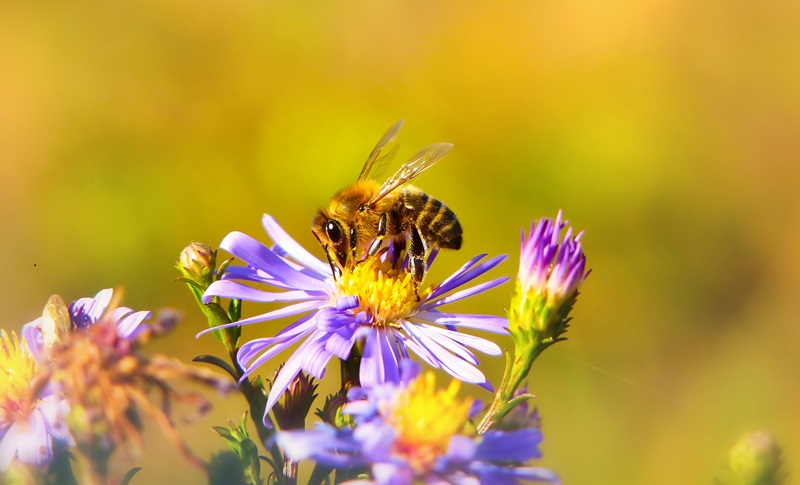Bees have been buzzing around pollinating plants, and facilitating biodiversity for several million years. An environmental biomonitoring species, bees respond to changes in their surroundings, and the nectar, pollen, and resins they carry back to their hives provide valuable environmental data. While individual bees are vulnerable to environmental stresses, bee colonies are more resilient and collect various environmental stressors, which can be analysed.
Each colony contains tens of thousands of forager bees, which interact with contaminants while collecting nectar and pollen. This results in the accumulation of pollutants like heavy metals, agrochemical pesticides, and air particulates in their honey, beeswax, collected pollen, and stored pollen. Bees’ widespread distribution and unique characteristics make them perfect for biomonitoring.
Bees and Sustainable Development Goals (SDGs)
The United Nations’ 17 Sustainable Development Goals (SDGs) aim to create harmony between humans and the environment by 2030, supported by 169 targets and over 200 indicators. Bees play a crucial role in achieving many of these goals. Some of their direct responsibilities for the environment include:
| SDG | The Environmental Role of Bees |
| Zero Hunger | Increase crop yields and enhance the nutritional value of food (2.2, 2.3). |
| Good health and well-being | Improve air quality through plant growth (3.9). |
| Clean water and sanitation | Support water-related ecosystems and improve water supplies (6.6). |
| Affordable and clean energy | Boost production of biofuel crops (7.2) |
| Sustainable Cities and Communities | Improve urban air quality and support urban gardens (11.6, 11.7) |
| Responsible Consumption and Production | Reduce food waste by enhancing food quality and shelf life (12.3). |
| Climate Action | Help monitor climate impacts on the environment (13.3). |
| Life Below Water | Support plant-based nutrient sources and reduce overfishing (14.4). |
| Life on Land | Contribute to biodiversity, forest conservation, reforestation, and poverty reduction (15.1, 15.5, 15.9). |
Bees in Carbon Sequestration
| Topic | Details |
| Honey Bees in North America | Responsible for pollinating over 100 commercial crops |
| Sunflower Seed Production | Honeybees and wild bees contribute approximately USD 10.4 million annually |
| Bee pollination in Sub-Saharan Africa | Increases cotton yield to 62% (up from 37% without bees). |
| Economic Returns in Kenya (Smallholder Farms) | Improves the production rates of various crops, responsible for almost 40% of annual crop production. |
| Economic Value of Honeybees (USA) | Approximately USD 6.4 billion in crop yield |
Bees play a crucial role in environmental sustainability and carbon sequestration.
Pollination
As an effective pollinator, they facilitate plant growth and CO2 absorption.
Biodiversity
According to research, bees are estimated to visit the top 90% of 107 crops in the world. Wild bees contribute an average of $251 per hectare to crop production. Like crops, bees also play a role in plant production, leading to improved biodiversity, and facilitating carbon sequestration.
Honeycomb
Beeswax contains honeycomb, which is a storehouse of pollen and honey. Through ventilation, honeycomb is indirectly involved in CO2 absorption.
Ecosystem Engineer
Bees are considered ecosystem engineers because of their direct and indirect role in maintaining ecosystems.
Nutrient cycle
Bees’ faecal matter is rich in organic nitrogen, which is decomposed in the soil into inorganic nitrogen and taken up by plants for their needs. Pollen is also nutrient-rich; it is the main diet of bees and plays an important role in the nutrient cycle of plants.
Soil health
Ground nesting bees play an important role in aerating and bioturbating the soil and improving growth conditions for plants.
Climate change’s effects on bees
As we know, bees are attracted to the scent and colour of flowers. The earth is warming, resulting in scent changes due to different chemical compositions. It leads to the loss of bee colonies. The loss of synchronisation in time after the bee’s hibernation and flowering of plants resulted in low seed production. Additionally, habitat loss has resulted in dramatic reductions in bee populations.
Conclusion
Scientists estimate that bees have existed for about 130 million years, evolving shortly after the first flowers bloomed. Their partnership with flowering plants has led to the emergence of approximately 20,000 bee species and an astounding 400,000 species of flowering plants. The decline in bee numbers over the past 300 years has put various species at risk of extinction, including 40% of invertebrate pollinators. Eight species of bees have been officially labelled endangered.
The potentially devastating impacts of climate change on bees highlight the urgent need for conservation. Key actions on the community level include:
Conservation of the habitats
Safeguard bee-friendly areas like coastal regions, grasslands, farmlands, and brownfield sites. This can be supported through strict environmental policies and rules to preserve these habitats.
Reversing Deforestation
Act by planting trees, as bees love their natural habitats. One can build bee-friendly spaces by planting wildflowers and cultivating wild grasses.
Stop using Harmful Chemicals
Avoid harmful pesticides, herbicides, and fertilisers, particularly neonicotinoids. Instead, farmers should adopt sustainable practices to increase their yields.
Apart from community-level actions, there are several individual steps we can take as follows:
- Advocate for a ban on harmful pesticides and promote sustainable organic practices
- Invest in creating bee-friendly environments with gardens full of diversity
- Buy organic products and locally available honey
- Educate others about the importance of bees in the ecosystem
World Bee Day is observed on May 20th to remind us that the bees’ fates are closely interlinked with our own. By taking active steps, we are protecting not only bees but also the diversity and health of the planet.
Source
Honey bees as biomonitors of environmental contaminants, pathogens, and climate change
Why bees are critical for achieving sustainable development
Review of the Role of Bees as Ecosystem Engineers in Nature
Overview of Bee Pollination and Its Economic Value for Crop Production
Beekeeping and Carbon Sequestration
How Does Climate Change Affect Bees?


